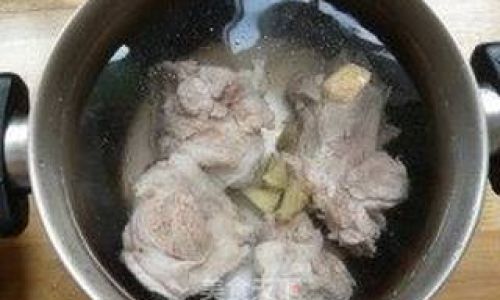Introduction
In the realm of comforting, nourishing soups, few dishes rival the humble yet profoundly satisfying Big Bone Radish Soup. A staple in many Asian households, this soup combines the earthy richness of slow-simmered bones with the crisp, refreshing sweetness of radish, creating a broth that is both restorative and deeply flavorful. Often served as a centerpiece during family meals or chilly evenings, this soup embodies the philosophy of using simple, wholesome ingredients to craft a dish that warms the soul. Whether you’re a seasoned home cook or a novice in the kitchen, mastering this recipe will equip you with a timeless skill that bridges tradition and modernity. This article will guide you through every step of crafting this beloved soup, from selecting the finest ingredients to achieving a broth so clear and aromatic it could rival any restaurant’s version.
The Cultural Significance of Big Bone Radish Soup
Before diving into the recipe, it’s worth understanding why this soup holds a special place in culinary traditions. In many Asian cultures, bone-based soups are revered for their perceived health benefits, including improved digestion, strengthened immunity, and enhanced vitality. Radish, or luobo in Chinese, is celebrated for its ability to detoxify the body and balance the richness of the bone broth. Together, these ingredients create a harmonious blend of taste and nutrition, making the soup a symbol of wholesome home cooking.
Ingredients: Building Blocks of Flavor
To recreate this classic dish, gather the following ingredients. Precision in measurements ensures balance, but feel free to adjust quantities based on personal preference.
- Bones: 2.2 lbs (1 kg) of pork or beef marrow bones (preferably with some meat attached)
- Radish: 1 large daikon radish (about 2.2 lbs/1 kg), peeled and cut into 1.5-inch chunks
- Ginger: 3-inch piece, sliced into thin strips
- Garlic: 4 cloves, lightly crushed
- Scallions: 2 stalks, finely chopped (for garnish)
- Water: 8 cups (2 liters), cold
- Salt: 1.5–2 tsp (adjust to taste)
- White Pepper: ½ tsp (optional, for warmth)
- Cooking Oil: 1 tbsp (neutral oil like vegetable or canola)
Optional Enhancements:
- A splash of rice wine or Shaoxing wine for depth.
- A handful of dried shiitake mushrooms (rehydrated) for umami.
- A star anise pod or cinnamon stick for subtle spice.
Preparation: The Foundation of Excellence

Preparing the Bones
The key to a milky-white, flavorful broth lies in properly treating the bones. Begin by rinsing the bones under cold water to remove any impurities. Fill a large pot with water, bring it to a boil, and blanch the bones for 5–7 minutes. This step, known as “parboiling,” eliminates blood and scum that could cloud the broth. Drain the bones and rinse them again under cold water to ensure no residue remains.
Sautéing Aromatics
In a clean, dry pot, heat the cooking oil over medium heat. Add the ginger strips and garlic cloves, sautéing until fragrant (about 1 minute). This step infuses the oil with aromatic oils, laying the groundwork for the broth’s complexity.
Simmering the Broth
Return the blanched bones to the pot, followed by the cold water. Using cold water ensures the bones release collagen slowly, resulting in a richer broth. Bring the mixture to a gentle boil, then reduce the heat to low. Skim off any foam that rises to the surface—this step is crucial for a clear broth. Cover the pot and let it simmer for at least 2 hours. For an even deeper flavor, extend the simmering time to 3–4 hours.

Introducing the Radish
About 30 minutes before serving, add the daikon chunks to the pot. The radish should be cut uniformly to ensure even cooking. Simmer until the radish turns translucent and tender, absorbing the broth’s essence without becoming mushy.
Seasoning to Perfection
Taste the broth and adjust the seasoning with salt and white pepper. Avoid over-salting; the soup’s natural sweetness should shine through. For a touch of brightness, a squeeze of fresh lime or a sprinkle of chopped cilantro can be added just before serving.
Serving Suggestions
Ladle the soup into bowls, ensuring each serving includes a generous portion of bones, radish, and broth. Garnish with chopped scallions and a drizzle of sesame oil for an aromatic finish. Pair with steamed rice, freshly baked bread, or noodles for a complete meal.

Expert Tips for Success
- Bone Selection: Opt for bones with visible marrow, as they impart the richest flavor. Ask your butcher to cut them into 2-inch pieces for easier handling.
- Radish Ripeness: Choose firm, unblemished daikon radishes. Avoid those with soft spots or a pungent smell, which indicate age.
- Skimming Technique: Use a fine-mesh skimmer to remove impurities without disturbing the broth. Repeat every 15 minutes during the initial simmer.
- Fat Removal: For a leaner broth, refrigerate the soup overnight. The fat will solidify on the surface, making it easy to scrape off.
Common Mistakes to Avoid
- Overcooking the Radish: Simmer radish for no longer than 30 minutes to prevent it from disintegrating.
- Using Hot Water: Starting with cold water ensures gentle collagen extraction.
- Rushing the Process: Patience is key—low, slow simmering builds depth of flavor.
Variations to Explore

- Vegetarian Twist: Substitute bones with vegetable stock and add kombu for umami.
- Spicy Kick: Incorporate sliced chili peppers or a dash of chili oil.
- Herbal Infusion: Toss in a bundle of fresh herbs like thyme or parsley during simmering.
Storage and Reheating
This soup stores exceptionally well. Transfer cooled portions to airtight containers and refrigerate for up to 5 days or freeze for 3 months. Reheat gently on the stovetop, adding a splash of water if the broth thickens.
The Health Benefits: More Than Just Comfort
Beyond its comforting embrace, Big Bone Radish Soup offers a wealth of nutritional benefits. Bone broth is rich in collagen, which supports joint health and skin elasticity. Radish, a low-calorie vegetable, provides dietary fiber, vitamin C, and antioxidants that aid digestion and boost immunity. Together, they create a dish that nourishes both body and spirit.
Conclusion: A Bowl of Tradition
In a world of hurried meals and processed foods, Big Bone Radish Soup stands as a testament to the beauty of slow cooking and simple ingredients. It’s a dish that connects generations, a reminder that true flavor requires time, care, and a willingness to embrace tradition. Whether you’re seeking solace on a cold evening or aiming to impress dinner guests, this soup delivers—one spoonful at a time. So gather your ingredients, light the stove, and let the sizzle of ginger and the aroma of simmering bones fill your kitchen. The result will be more than a meal; it’ll be a culinary embrace.






0 comments